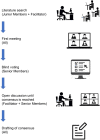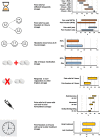European Headache Federation (EHF) consensus on the definition of effective treatment of a migraine attack and of triptan failure
- PMID: 36224519
- PMCID: PMC9555163
- DOI: 10.1186/s10194-022-01502-z
European Headache Federation (EHF) consensus on the definition of effective treatment of a migraine attack and of triptan failure
Abstract
Background: Triptans are migraine-specific acute treatments. A well-accepted definition of triptan failure is needed in clinical practice and for research. The primary aim of the present Consensus was to provide a definition of triptan failure. To develop this definition, we deemed necessary to develop as first a consensus definition of effective treatment of an acute migraine attack and of triptan-responder.
Main body: The Consensus process included a preliminary literature review, a Delphi round and a subsequent open discussion. According to the Consensus Panel, effective treatment of a migraine attack is to be defined on patient well-being featured by a) improvement of headache, b) relief of non-pain symptoms and c) absence of adverse events. An attack is considered effectively treated if patient's well-being, as defined above, is restored within 2 hours and for at least 24 hours. An individual with migraine is considered as triptan-responder when the given triptan leads to effective acute attack treatment in at least three out of four migraine attacks. On the other hand, an individual with migraine is considered triptan non-responder in the presence of failure of a single triptan (not matching the definition of triptan-responder). The Consensus Panel defined an individual with migraine as triptan-resistant in the presence of failure of at least 2 triptans; triptan refractory, in the presence of failure to at least 3 triptans, including subcutaneous formulation; triptan ineligibile in the presence of an acknowledged contraindication to triptan use, as specified in the summary of product characteristics.
Conclusions: The novel definitions can be useful in clinical practice for the assessment of acute attack treatments patients with migraine. They may be helpful in identifying people not responding to triptans and in need for novel acute migraine treatments. The definitions will also be of help in standardizing research on migraine acute care.
Keywords: Attack; Ditan; Gepant; Headache; Migraine; NSAIDs; Triptan.
© 2022. The Author(s).
Conflict of interest statement
Competing interests are reported in Supplemental File Table S9.
Figures




References
Publication types
MeSH terms
Substances
LinkOut - more resources
Full Text Sources
Medical

